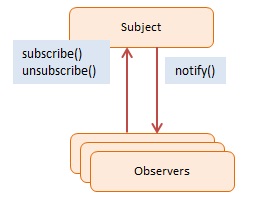Define a one-to-many dependency between objects so that when one object changes state, all its dependents are notified and updated automatically.
| Usage in JavaScript: |
|
high |
The Observer pattern offers a subscription model in which objects subscribe to an event and get notified when the event occurs. This pattern is the cornerstone of event driven programming, including JavaScript. The Observer pattern facilitates good object-oriented design and promotes loose coupling.
When building web apps you end up writing many event handlers. Event handlers are functions that will be notified when a certain event fires. These notifications optionally receive an event argument with details about the event (for example the x and y position of the mouse at a click event).
The event and event-handler paradigm in JavaScript is the manifestation of the Observer design pattern. Another name for the Observer pattern is Pub/Sub, short for Publication/Subscription.

The Click object represents the Subject. The clickHandler function is the subscribing Observer. This handler subscribes, unsubscribes, and then subscribes itself while events are firing. It gets notified only of events #1 and #3.
Notice that the fire method accepts two arguments. The first one has details about the event and the second one is the context, that is, the this value for when the eventhandlers are called. If no context is provided this will be bound to the global object (window).
The log function is a helper which collects and displays results.
function Click() {
this.handlers = []; // observers
}
Click.prototype = {
subscribe: function(fn) {
this.handlers.push(fn);
},
unsubscribe: function(fn) {
this.handlers = this.handlers.filter(
function(item) {
if (item !== fn) {
return item;
}
}
);
},
fire: function(o, thisObj) {
var scope = thisObj || window;
this.handlers.forEach(function(item) {
item.call(scope, o);
});
}
}
// log helper
var log = (function() {
var log = "";
return {
add: function(msg) { log += msg + "\n"; },
show: function() { alert(log); log = ""; }
}
})();
function run() {
var clickHandler = function(item) {
log.add("fired: " + item);
};
var click = new Click();
click.subscribe(clickHandler);
click.fire('event #1');
click.unsubscribe(clickHandler);
click.fire('event #2');
click.subscribe(clickHandler);
click.fire('event #3');
log.show();
}
Run
The JavaScript environment is event-driven and the Observer pattern is built-in. There is no need to reinvent the wheel so we will use what is available. Unfortunately, the native event handling is different across browsers. But lucky for us, jQuery does a fantastic job of shielding developers from browser differences and it offers sophisticated event management and event handling, including custom events.
Here we have a div element on the page to which we attach three different event handlers using jQuery's on method. You will see that all three handlers execute when the 'poke' event gets triggered ('poke' is a custom event). At the end of the code we detach all event handlers with a single call to jQuery's off method.
// log helper
var log = (function () {
var log = "";
return {
add: function (msg) { log += msg + "\n"; },
show: function () { alert(log); log = ""; }
}
})();
function run() {
var div = jQuery("#div");
// attach three event handlers
div.on("poke", function () { log.add("poke handler 1"); });
div.on("poke", function () { log.add("poke handler 2"); });
div.on("poke", function () { log.add("poke handler 3"); });
// trigger event
div.trigger('poke');
log.show();
// detach event handlers
div.off("poke");
}
Run